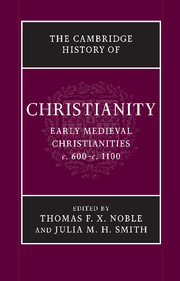Book contents
- Frontmatter
- Introduction: Christendom, c. 600
- Part I Foundations: Peoples, Places, and Traditions
- Part II Christianity in Confrontation
- Part III Christianity in the Social and Political Order
- Part IV Christianity as Lived Experience
- 18 Birth and death
- 19 Remedies for sins
- 20 Sickness and healing
- 21 Gender and the body
- 22 Sacrifice, gifts, and prayers in Latin Christianity
- 23 Performing the liturgy
- Part V Christianity: Books and Ideas
- Conclusion: Christendom, c. 1100
- Bibliographies
- Index
- References
18 - Birth and death
from Part IV - Christianity as Lived Experience
Published online by Cambridge University Press: 28 March 2010
- Frontmatter
- Introduction: Christendom, c. 600
- Part I Foundations: Peoples, Places, and Traditions
- Part II Christianity in Confrontation
- Part III Christianity in the Social and Political Order
- Part IV Christianity as Lived Experience
- 18 Birth and death
- 19 Remedies for sins
- 20 Sickness and healing
- 21 Gender and the body
- 22 Sacrifice, gifts, and prayers in Latin Christianity
- 23 Performing the liturgy
- Part V Christianity: Books and Ideas
- Conclusion: Christendom, c. 1100
- Bibliographies
- Index
- References
Summary
When responding to birth and death, early medieval Christians leaned heavily upon two fundamental features of their culture: the centrality of birth, death, and resurrection in their faith, and the importance of families in their mental horizons and social organization. Over the course of the early Middle Ages, most Christians came to regard the baptism of newborns as a necessary and normal initiation into church, kin, and Christian society. At the same time, liturgical specialists expanded the comparatively simple funeral and commemorative practices of Christian antiquity into a fully articulated rite of passage meant to facilitate each step of the transition from the community of the living to the community of the faithful departed: preparing body and soul for death itself, properly disposing of the corporeal remains, and overseeing the successful incorporation of the soul into the ranks of the blessed. The faithful, both new and old, also gave up a variety of more or less ancient burial practices for an almost universal pattern of simple interment in and around churches at the heart of settled areas. When they did, the living and the dead became members of a single community, united in space and time. Overall, the business of preparing Christians for death and seeing to their welfare in the afterlife, which began at baptism, gave rise to an extraordinary system of spiritual and temporal exchange – an economy of salvation, based on gift-giving and fueled by the circulation of people, prayers, and property – that is one of the most striking features of the age.
- Type
- Chapter
- Information
- The Cambridge History of Christianity , pp. 381 - 398Publisher: Cambridge University PressPrint publication year: 2008
References
- 2
- Cited by

